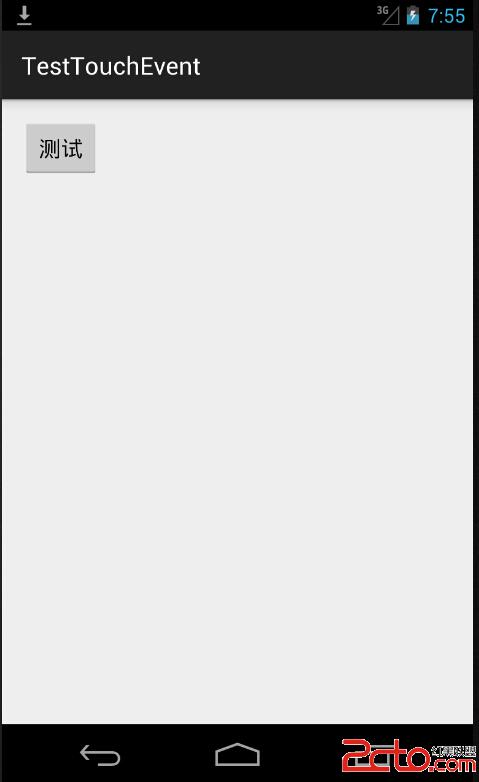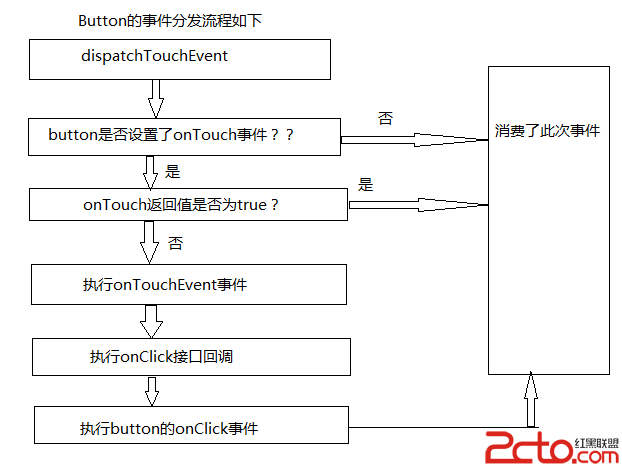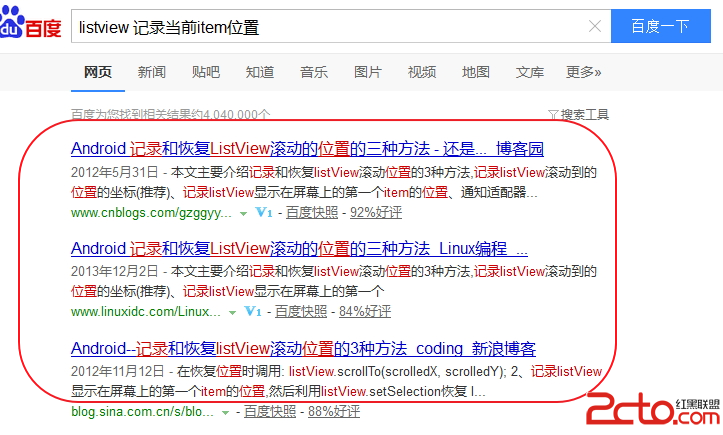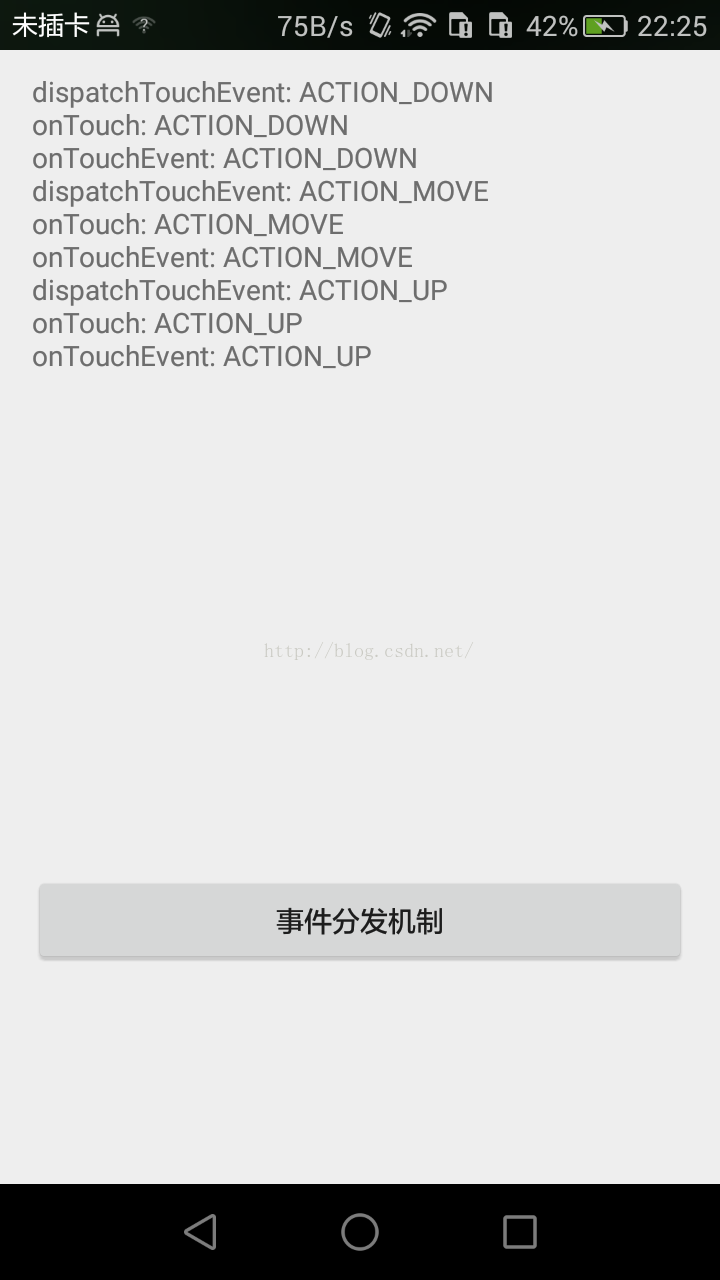編輯:關於Android編程
關於Android View 事件分發過程的文章網絡上可以搜到一把大,這裡貼一篇代碼性的文章,作者也是個牛人:Android事件分發機制完全解析,帶你從源碼的角度徹底理解(上)。
雖然講的很好,但是看完之後還是感覺有那麼點一知半解,於是自己花了點時間從源碼研究android 觸摸事件分發流程,以下內容僅僅個人理解,如有差錯希望指出。
我們先從一個例子看起,先重寫一個MyButton 繼承Button,代碼如下:
public class MyButton extends Button {
public MyButton(Context context) {
super(context);
}
public MyButton(Context context, AttributeSet attrs) {
super(context, attrs);
}
public MyButton(Context context, AttributeSet attrs, int defStyleAttr) {
super(context, attrs, defStyleAttr);
}
@Override
public boolean dispatchTouchEvent(MotionEvent event) {
switch (event.getAction()) {
case MotionEvent.ACTION_DOWN:
MyLog.e("dispatchTouchEvent====MyButton=====ACTION_DOWN");
break;
case MotionEvent.ACTION_MOVE:
MyLog.e("dispatchTouchEvent====MyButton=====ACTION_MOVE");
break;
case MotionEvent.ACTION_UP:
MyLog.e("dispatchTouchEvent====MyButton=====ACTION_UP");
break;
}
return super.dispatchTouchEvent(event);
}
@Override
public boolean onTouchEvent(MotionEvent event) {
switch (event.getAction()) {
case MotionEvent.ACTION_DOWN:
MyLog.e("onTouchEvent====MyButton=====ACTION_DOWN");
break;
case MotionEvent.ACTION_MOVE:
MyLog.e("onTouchEvent====MyButton=====ACTION_MOVE");
break;
case MotionEvent.ACTION_UP:
MyLog.e("onTouchEvent====MyButton=====ACTION_UP");
break;
}
return super.onTouchEvent(event);
}
布局文件如下:
public class MainActivity extends ActionBarActivity {
private Button myButton;
@Override
protected void onCreate(Bundle savedInstanceState) {
super.onCreate(savedInstanceState);
setContentView(R.layout.activity_main);
myButton = (Button) findViewById(R.id.myButton);
myButton.setOnTouchListener(new View.OnTouchListener() {
@Override
public boolean onTouch(View v, MotionEvent event) {
switch (event.getAction()) {
case MotionEvent.ACTION_DOWN:
MyLog.e("onTouch====MyButton=====ACTION_DOWN");
break;
case MotionEvent.ACTION_MOVE:
MyLog.e("onTouch====MyButton=====ACTION_MOVE");
break;
case MotionEvent.ACTION_UP:
MyLog.e("onTouch====MyButton=====ACTION_UP");
break;
}
return false;
}
});
myButton.setOnClickListener(new View.OnClickListener() {
@Override
public void onClick(View v) {
MyLog.e("onClick====MyButton=====onClick");
}
});
}
}


我們從打印結果可以直觀看到,點擊Button按鈕事件分發過程如下 dispatchTouchEvent---->onTouch---->onTouchEvent----->onClick。並且如果仔細的你會發現,都是在ACTION_UP事件之後才觸發onClick點擊事件,為什麼會是這樣??現在我們不得而知。我們僅僅是從打印結果推測事件分發的結論,現在我們從源碼分析下這個事件分發流程為什麼是這樣子。
事件分發都是從dispatchTouchEvent方法開始的,那麼我們這裡是重寫了dispatchTouchEvent方法,並且最後也調用了父類的super.dispatchTouchEvent(event)方法。那麼我們看看父類中的方法到底做了什麼??點擊進入父類的dispatchTouchEvent方法,發現此方法在View類中找到,其實也不奇怪,所有控件的父類都是View。這裡我貼出最新源碼如下:
public boolean dispatchTouchEvent(MotionEvent event) {
boolean result = false;
if (mInputEventConsistencyVerifier != null) {
mInputEventConsistencyVerifier.onTouchEvent(event, 0);
}
final int actionMasked = event.getActionMasked();
if (actionMasked == MotionEvent.ACTION_DOWN) {
// Defensive cleanup for new gesture
stopNestedScroll();
}
if (onFilterTouchEventForSecurity(event)) {
//noinspection SimplifiableIfStatement
ListenerInfo li = mListenerInfo;
if (li != null && li.mOnTouchListener != null
&& (mViewFlags & ENABLED_MASK) == ENABLED
&& li.mOnTouchListener.onTouch(this, event)) {
result = true;
}
if (!result && onTouchEvent(event)) {
result = true;
}
}
if (!result && mInputEventConsistencyVerifier != null) {
mInputEventConsistencyVerifier.onUnhandledEvent(event, 0);
}
// Clean up after nested scrolls if this is the end of a gesture;
// also cancel it if we tried an ACTION_DOWN but we didn't want the rest
// of the gesture.
if (actionMasked == MotionEvent.ACTION_UP ||
actionMasked == MotionEvent.ACTION_CANCEL ||
(actionMasked == MotionEvent.ACTION_DOWN && !result)) {
stopNestedScroll();
}
return result;
}
忽略其他無關代碼,我們直接看17--25行。第17行的if判斷關鍵在於li.mOnTouchListener.onTouch(this, event) 的返回值,這個接口回調就是我們外面寫的myButton.setOnTouchListener事件(Button 的onTouch事件),在MainActivity代碼裡,我們setOnTouchListener返回的值是false,所以在源碼中我們可以看到 17行的條件不成立,那麼條件不成立,result=false;因此,源碼的第23行if 判斷第一個條件成立,繼續執行第二個條件,也就是onTouchEvent。我們跳到這個方法裡看看裡面干啥了?看如下代碼:
public boolean onTouchEvent(MotionEvent event) {
if (((viewFlags & CLICKABLE) == CLICKABLE ||
(viewFlags & LONG_CLICKABLE) == LONG_CLICKABLE)) {
switch (event.getAction()) {
case MotionEvent.ACTION_UP:
boolean prepressed = (mPrivateFlags & PFLAG_PREPRESSED) != 0;
if ((mPrivateFlags & PFLAG_PRESSED) != 0 || prepressed) {
// take focus if we don't have it already and we should in
// touch mode.
boolean focusTaken = false;
if (isFocusable() && isFocusableInTouchMode() && !isFocused()) {
focusTaken = requestFocus();
}
if (prepressed) {
// The button is being released before we actually
// showed it as pressed. Make it show the pressed
// state now (before scheduling the click) to ensure
// the user sees it.
setPressed(true, x, y);
}
if (!mHasPerformedLongPress) {
// This is a tap, so remove the longpress check
removeLongPressCallback();
// Only perform take click actions if we were in the pressed state
if (!focusTaken) {
// Use a Runnable and post this rather than calling
// performClick directly. This lets other visual state
// of the view update before click actions start.
if (mPerformClick == null) {
mPerformClick = new PerformClick();
}
if (!post(mPerformClick)) {
performClick();
}
}
}
if (mUnsetPressedState == null) {
mUnsetPressedState = new UnsetPressedState();
}
if (prepressed) {
postDelayed(mUnsetPressedState,
ViewConfiguration.getPressedStateDuration());
} else if (!post(mUnsetPressedState)) {
// If the post failed, unpress right now
mUnsetPressedState.run();
}
removeTapCallback();
}
break;
return true;
}
return false;
}
public boolean performClick() {
final boolean result;
final ListenerInfo li = mListenerInfo;
if (li != null && li.mOnClickListener != null) {
playSoundEffect(SoundEffectConstants.CLICK);
li.mOnClickListener.onClick(this);
result = true;
} else {
result = false;
}
sendAccessibilityEvent(AccessibilityEvent.TYPE_VIEW_CLICKED);
return result;
}
看見沒??第6行 li.mOnClickListener.onClick(this); 這個接口回調就是我們Button的 onClick事件。到此為止,我們從源碼分析了Button事件分發過程
現在我們來看看其他情況:當onTouch返回為true,打印結果如下:

驚奇的發現,竟然沒有執行onClick事件是吧????如果你仔細閱讀上面的文章,估計你知道為什麼了吧?還是跟大家一起分析一下吧:源碼如下:
public boolean dispatchTouchEvent(MotionEvent event) {
boolean result = false;
if (mInputEventConsistencyVerifier != null) {
mInputEventConsistencyVerifier.onTouchEvent(event, 0);
}
final int actionMasked = event.getActionMasked();
if (actionMasked == MotionEvent.ACTION_DOWN) {
// Defensive cleanup for new gesture
stopNestedScroll();
}
if (onFilterTouchEventForSecurity(event)) {
//noinspection SimplifiableIfStatement
ListenerInfo li = mListenerInfo;
if (li != null && li.mOnTouchListener != null
&& (mViewFlags & ENABLED_MASK) == ENABLED
&& li.mOnTouchListener.onTouch(this, event)) {
result = true;
}
if (!result && onTouchEvent(event)) {
result = true;
}
}
if (!result && mInputEventConsistencyVerifier != null) {
mInputEventConsistencyVerifier.onUnhandledEvent(event, 0);
}
// Clean up after nested scrolls if this is the end of a gesture;
// also cancel it if we tried an ACTION_DOWN but we didn't want the rest
// of the gesture.
if (actionMasked == MotionEvent.ACTION_UP ||
actionMasked == MotionEvent.ACTION_CANCEL ||
(actionMasked == MotionEvent.ACTION_DOWN && !result)) {
stopNestedScroll();
}
return result;
}
給個簡單的流程圖如下

因此,事件分發之間的關系是:dispatchTouchEvent方法中線執行 onTouch接口回調,然後根據onTouch方法的返回值判斷是否執行onTouchEvent方法,onTouchEvent方法中執行了onClick接口回調。
 android開發之記錄ListView滾動位置
android開發之記錄ListView滾動位置
這個問題本身不難,但是由於項目中的需求太過於復雜,結果導致這個問題變得不是那麼容易實現。在網上一搜,結果如下:int scrollPos = refreshListVie
 Android Listview上下拉動刷新tab滑動切換功能
Android Listview上下拉動刷新tab滑動切換功能
近期要做一個含有兩個tab切換頁面,兩個頁面有公共的描述信息區域,兩個tab都是listview,可以向上或向下拉動刷新,在頁面中部有一個tab切換區域,向上滑動的時候t
 View的事件分發機制學習筆記
View的事件分發機制學習筆記
好不容易周末有空,作為一個零基礎非計算機專業剛培訓出來7個月的小白,對付博大精深的Android源碼真的是心有余而力不足,但是東西還是要學滴,這不!找到Hongyang大
 android Tween Animation屬性設置方法實例
android Tween Animation屬性設置方法實例
在Android開發中,Animation是用來給控件制作效果的。大多數的控件都可以用這個類,這個類包含了4種基本動作,分別為移動,旋轉,淡入淡出,縮放。在使用Anima